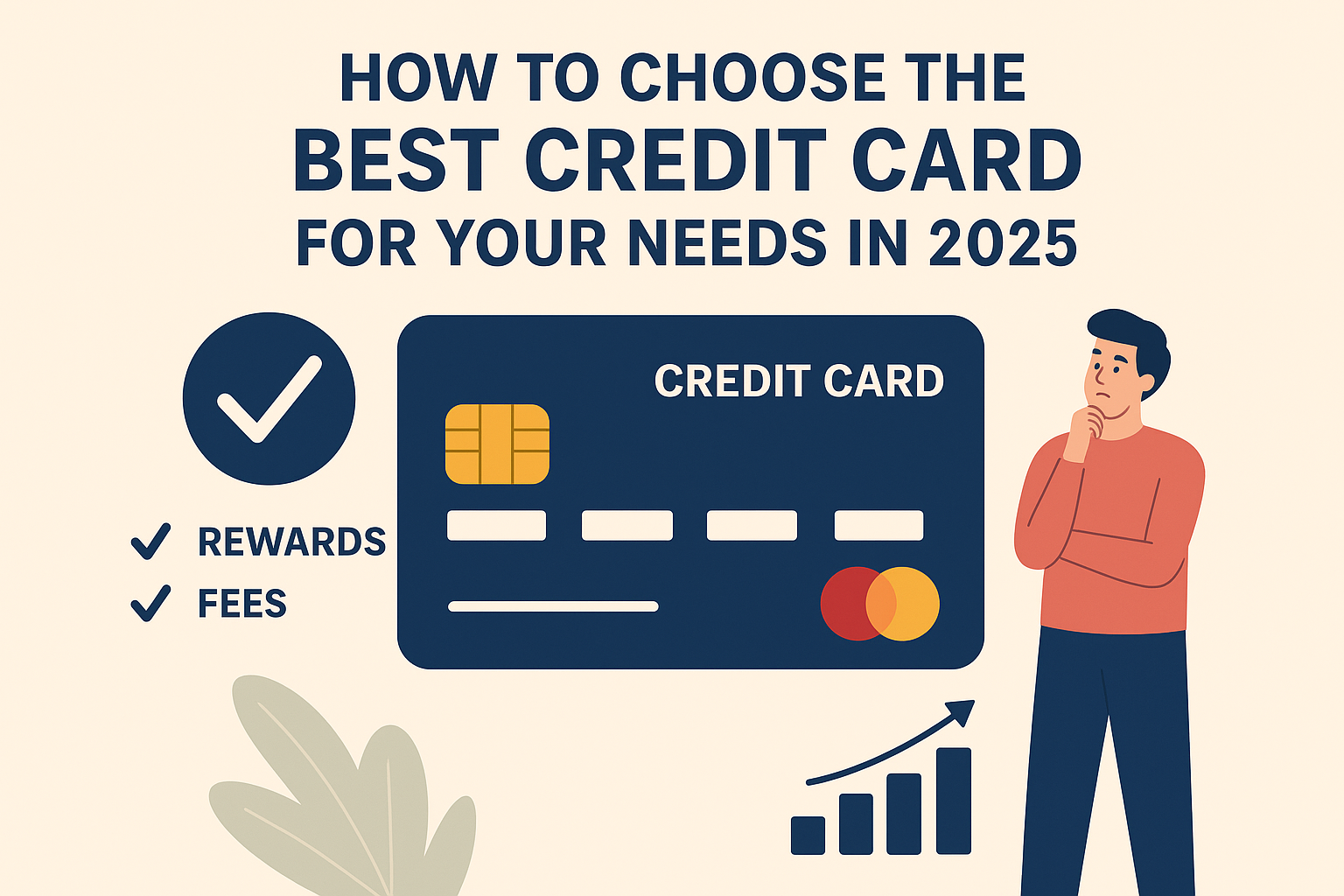How to Choose the Best Credit Card for Your Needs in 2025
Choosing the right credit card in 2025 can feel overwhelming. With hundreds of options available—from travel rewards to cashback, low-interest cards, and premium perks—it’s not always easy to know which one fits your lifestyle. Picking the wrong card could mean paying unnecessary fees or missing out on valuable rewards. The good news? With the right approach, you can identify the card that maximizes your benefits while minimizing costs.
This guide will walk you through everything you need to consider when choosing the best credit card in 2025, including card types, fees, interest rates, and how to match features with your financial goals.
Why Choosing the Right Credit Card Matters
A credit card isn’t just a payment tool—it can be a financial partner. The right card can:
-
Save you money with low interest or 0% intro APR offers.
-
Earn rewards on everyday spending like groceries, gas, or travel.
-
Provide peace of mind with purchase protection, travel insurance, and fraud protection.
-
Help build or rebuild credit when used responsibly.
On the other hand, the wrong card may cost you hundreds of dollars annually in hidden fees and interest charges.
Step 1: Understand Your Financial Goals
Before you compare credit cards, define what you want to achieve. Ask yourself:
-
Do you want to earn cashback on daily purchases?
-
Do you plan to travel frequently and benefit from airline miles or hotel rewards?
-
Are you trying to pay down debt with a low-interest or balance transfer card?
-
Do you want to build your credit score as a beginner or student?
Your answer determines the type of credit card that suits you best.
Step 2: Explore the Main Types of Credit Cards in 2025
Here are the most common categories of credit cards, and who they’re best for:
1. Cashback Credit Cards
-
Best for: Everyday spenders who want simplicity.
-
Earn a flat percentage (e.g., 1.5%–2%) on all purchases or higher rates (up to 6%) in specific categories like dining, groceries, or fuel.
-
Great for people who don’t want to track complicated rewards systems.
2. Travel Rewards Cards
-
Best for: Frequent travelers.
-
Earn miles or points redeemable for flights, hotels, or travel upgrades.
-
Perks may include free checked bags, airport lounge access, or travel insurance.
-
Usually come with higher annual fees, but frequent travelers can easily outweigh the cost.
3. Balance Transfer Cards
-
Best for: Paying off debt.
-
Offer 0% intro APR on balance transfers for 12–21 months.
-
Allows you to consolidate high-interest debt and pay it off faster.
4. Low-Interest Cards
-
Best for: Those who carry a balance.
-
Provide ongoing lower interest rates compared to standard cards.
-
Less about rewards, more about saving money on interest.
5. Student or Secured Credit Cards
-
Best for: Credit-building beginners.
-
Easier approval for students or those with limited/no credit history.
-
Secured cards require a refundable deposit as collateral.
Step 3: Compare Key Features
When comparing credit cards in 2025, look beyond flashy marketing. Focus on these features:
Interest Rates (APR)
-
Check the purchase APR, balance transfer APR, and cash advance APR.
-
Many cards offer 0% intro APR for a limited period.
Annual Fees
-
Ranges from $0 to $500+ for premium cards.
-
Only pay a higher fee if the rewards outweigh the cost.
Rewards Programs
-
Look at earning rates (e.g., 3% on dining, 5% on groceries).
-
Consider redemption options: cashback, travel, gift cards, or statement credits.
Signup Bonuses
-
Many cards offer welcome bonuses (e.g., 50,000 points after spending $3,000 in 3 months).
-
Check if you can realistically meet the spending requirement.
Foreign Transaction Fees
-
If you travel internationally, choose a card with no foreign transaction fees.
Perks & Benefits
-
Travel insurance
-
Purchase protection
-
Extended warranty
-
Lounge access
-
Roadside assistance
Step 4: Match the Card to Your Lifestyle
Here are some examples to help you choose:
-
If you spend $500/month on groceries and gas: A cashback card with 3–5% in those categories could save you $300+ a year.
-
If you travel abroad twice a year: A travel rewards card with free checked bags and no foreign fees may save you $400 annually.
-
If you’re carrying $5,000 in debt at 20% interest: A balance transfer card with 0% APR for 18 months could save you $1,500+ in interest.
Step 5: Check Your Credit Score
Most rewards and travel cards require good to excellent credit (670+). If your score is lower, start with a secured card or a student card to build credit, then upgrade later.
Step 6: Apply and Use Responsibly
Once you’ve chosen a card:
-
Apply online with accurate income and financial details.
-
Use your card responsibly—always pay at least the minimum on time.
-
Keep your credit utilization below 30% of your limit.
-
Track your rewards and benefits so you don’t miss out.
Tips to Maximize Your Credit Card in 2025
-
Automate payments to avoid late fees.
-
Use multiple cards strategically (e.g., one for groceries, one for travel).
-
Take advantage of perks like free credit score monitoring.
-
Reevaluate your card annually—your needs may change.
Conclusion
Choosing the best credit card in 2025 depends on your financial goals and lifestyle. Whether you want cashback, travel rewards, low interest, or a way to build credit, there’s a card designed for you. By comparing fees, interest rates, and perks, you can avoid costly mistakes and unlock valuable benefits.

